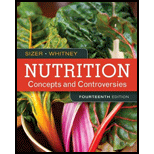
Introduction:
Organic food is produced by farming methods which prevent the use of man-made pesticides, fertilizers, additives in livestock feed, and growth regulators. In the United States, the United States Department of Agriculture (USDA) runs a National Organic Program (NOP). NOP settles regulations for organic products that are imported for sale or produced in the United States.
Explanation of Solution
Correct answer:
Products labeled as 100% organic must contain 100% organic ingredients. All the ingredients in the product should be certified as organic by USDA.
Justify the reason for the correct answer:
Option (d) is given as contains only 100% organic ingredients. Excluding the salt and water, the product must contain material which is produced organically. The name of the agent certifying the product must also appear on the package. Hence, option (c) is correct.
Justify the reason for the incorrect statements:
Option (a) is given as be inspected before it is sold. Organic food either with 100% or less organic content must pass the inspections of USDA at every step of production to the labeling of the product. So, it is a wrong answer.
Option (b) is given as contain at least 95% of organic ingredients. Food labeled as organic must contain at least 95% of the organic ingredients. So, it is a wrong answer.
Option (c) is given as be labeled natural or free range. Words such as free range, natural, or locally grown are not considered by any standards to carry the claim of being organic. So, it is a wrong answer.
Hence, options (a), (b), and (c) are incorrect.
A product labeled as 100% organic must contain certified organic content. The product must fulfill the criteria of 100% organic given by USDA.
Want to see more full solutions like this?
Chapter 12 Solutions
Nutrition: Concepts and Controversies - Standalone book (MindTap Course List)
 Nutrition: Concepts and Controversies - Standalo...Health & NutritionISBN:9781305627994Author:Frances Sizer, Ellie WhitneyPublisher:Brooks Cole
Nutrition: Concepts and Controversies - Standalo...Health & NutritionISBN:9781305627994Author:Frances Sizer, Ellie WhitneyPublisher:Brooks Cole Nutrition Through The Life CycleHealth & NutritionISBN:9781337919333Author:Brown, Judith E.Publisher:Cengage Learning,Lifetime Physical Fitness & WellnessHealth & NutritionISBN:9781337677509Author:HOEGERPublisher:CengageHealth Safety And Nutrition F/Young ChildHealth & NutritionISBN:9781305144767Author:MAROTZPublisher:Cengage
Nutrition Through The Life CycleHealth & NutritionISBN:9781337919333Author:Brown, Judith E.Publisher:Cengage Learning,Lifetime Physical Fitness & WellnessHealth & NutritionISBN:9781337677509Author:HOEGERPublisher:CengageHealth Safety And Nutrition F/Young ChildHealth & NutritionISBN:9781305144767Author:MAROTZPublisher:Cengage





